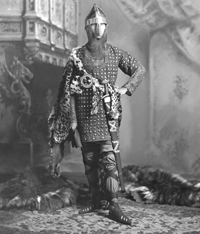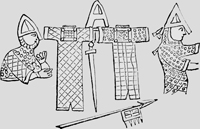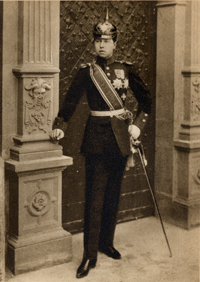Hereditary Prince Alfred of Saxe Coburg Gotha (1874-1899),
The only son of Queen Victoria's second son, Prince Albert had been sent off for a German education in Potsdam by his anglophobe mother, Grand Duchess Marie of Russia, as soon as her husband was named heir to the duchy of Saxe Coburg Gotha. It was perhaps through the efforts of his mother that his abortive engagement was announced, in January 1897, to Princess Feodore of Saxe Meiningen, a great-granddaughter of Queen Victoria. His Teutonic upbringing did not improve his character, as his sister, the Crown Princess Marie of Romania, noted in her diary:
Almost a ‘Germanised’ stranger to his family, and beyond parental supervision, he fell into what was termed bad ways, or as the Empress Frederick stated in a letter to her daughter, Sophie, he was “heedless and giddy to resist temptations, bad examples” and he contracted syphilis – “an illness of which I know next to nothing.” Hardly a year after this image was made, Prince Alfred made a visit to his sister in Sinaia, Romania. Marie found him “pale and emaciated... his young life wasting away… He hardly recognizes anyone and often does not know what he says, poor boy.” In 1899 at the time of his parents’ silver wedding celebrations in Coburg he was sent by his mother to Meran in the Tyrol to recover from ‘nervous depression’ – actually a self-inflicted gunshot wound after an argument with his parents. He died less than a fortnight later with his death being officially noted to have been caused by ‘chronic cerebral affection’. After Alfred’s death some sources claim that his father never spent another night under the same roof as his mother. For the Ball, Alfred chose to represent Duke Robert of Normandy, son of William the Conqueror who led the Normans in their conquest of England in 1066. The costume appears to be inspired by the type of uniforms seen in the Bayeux tapestry. Chain mail was known to the Saxons well before 1066 and Aldhelm, Bishop of Sherborne (709) described it enigmatically thus: "produced from the cold bowels of the dewy earth, and neither spun from the wool of the sheep nor the yellow down of the silkworm, nor woven in a loom, nor carded by the wool-comb, it is, strange to say, called a garment.” Its historical veracity was assured before the event by the historical painter John Seymour Lucas (1849-1923) who in 1902 used a group portrait by Lafayette to paint the phenomenally accurate Reception by HM King Edward VII of the Moorish Ambassador. Prince Alfred even wears an authentic conical Norman helmet with steel nose-protector - not an obviously comfortable choice of headgear for a party! The choice of role, hinting at the defeat of England by a foreign power, possibly reflected his mother’s antipathy to all things English. |
Click on image to enlarge
|
||
|

 V&A Lafayette Archive
V&A Lafayette Archive Helmets, hauberks, a sword, and a gonfanon, from the Bayeux tapestry as illustrated by Planché in his History of British Costume.
Helmets, hauberks, a sword, and a gonfanon, from the Bayeux tapestry as illustrated by Planché in his History of British Costume. "Alfred at the age of eighteen" – a photograph reproduced in one of the autobiograpies of his sister, Marie, Queen of Romania
"Alfred at the age of eighteen" – a photograph reproduced in one of the autobiograpies of his sister, Marie, Queen of Romania